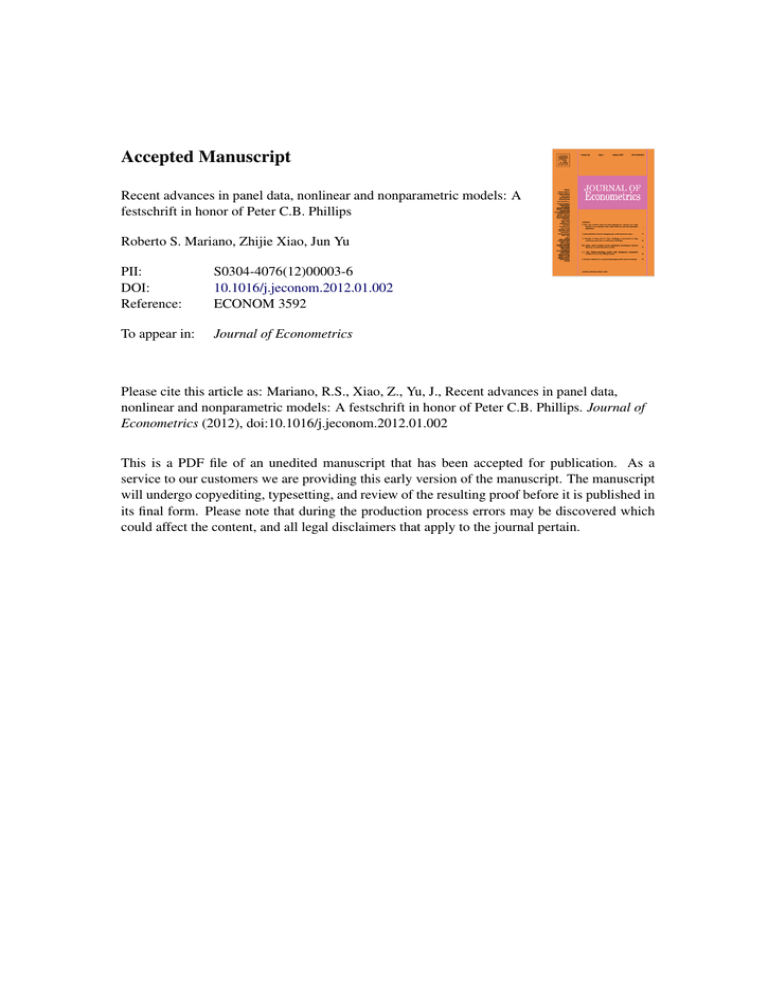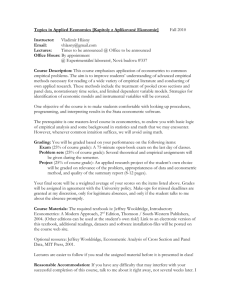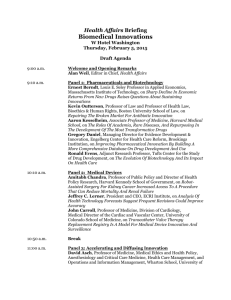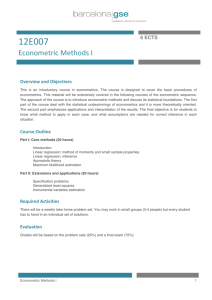Accepted Manuscript
advertisement

Accepted Manuscript Recent advances in panel data, nonlinear and nonparametric models: A festschrift in honor of Peter C.B. Phillips Roberto S. Mariano, Zhijie Xiao, Jun Yu PII: DOI: Reference: S0304-4076(12)00003-6 10.1016/j.jeconom.2012.01.002 ECONOM 3592 To appear in: Journal of Econometrics Please cite this article as: Mariano, R.S., Xiao, Z., Yu, J., Recent advances in panel data, nonlinear and nonparametric models: A festschrift in honor of Peter C.B. Phillips. Journal of Econometrics (2012), doi:10.1016/j.jeconom.2012.01.002 This is a PDF file of an unedited manuscript that has been accepted for publication. As a service to our customers we are providing this early version of the manuscript. The manuscript will undergo copyediting, typesetting, and review of the resulting proof before it is published in its final form. Please note that during the production process errors may be discovered which could affect the content, and all legal disclaimers that apply to the journal pertain. Recent Advances in Panel Data, Nonlinear and Nonparametric Models: A Festschrift in Honor of Peter C. B. Phillips Roberto S. Mariano, Zhijie Xiao, Jun Yu December 26, 2011 1 About the Special Issue On July 14 - 15, 2008, the School of Economics and the Sim Kee Boon Institute for Financial Economics at Singapore Management University (SMU) co-hosted a conference honoring Peter Phillips’ contribution to econometrics and statistics in celebration of his 60th birthday. In total, 51 papers were presented by his colleagues and former students who deeply appreciate and respect Peter as a true scholar and a good friend. These papers mainly cover two areas of Peter’s current research interest - nonstationary time series analysis, and panel, nonlinear and nonparametric models. Based on this conference, we have taken the opportunity to edit two special issues of the Journal of Econometrics (JoE), focused on these two research areas, to honor Peter Phillips on his 60th birthday. All papers in the two issues were selected from the SMU conference presentations and subjected to JoE’s normal refereeing process. This special issue contains 12 papers dealing with panel, nonlinear, and nonparametric models. Peter has written a number of important papers on the study of panel data models where, unlike earlier treatment, he assumes the time series length, T , is large. The first six papers in this issue are concerned with panel data models. The first paper, “Nonparametric Trending Regression with Cross-Sectional Dependence,” by Peter Robinson, considers a panel data model with a common time trend in time series. The series length is assumed to be large but cross-section size, N , need not be. The interesting feature of the model is that the time trend is of unknown form, and hence, the model includes additive, unknown, individual-specific components, and allows for spatial or other cross-sectional dependence and/or heteroscedasticity. An estimate which exploits 1 the availability of cross-sectional data dominates a simple smoothed nonparametric trend estimate. Asymptotically optimal choices of bandwidth are justified for both estimates. Feasible optimal bandwidths, and feasible optimal trend estimates, are asymptotically justified, and the finite-sample performance of the latter is examined in a Monte Carlo study. In “Taking a New Contour: A Novel Approach to Panel Unit Root Tests,” Chang introduces a new procedure for testing for unit roots in panels, which takes a new contour that is drawn along the line given by the equi-squared-sum instead of the traditional one given by equi-sample-size. She then shows that the distributions of the unit root test statistics are asymptotically normal along the new contour under both the null and the local-to-unity alternatives. This suggests new tools and methodologies for effective inference in panel unit root models. Simulations show that the approach works quite well in finite samples. Moon and Perron also study the problem of testing for unit roots in panels in “Beyond Panel Unit Root Tests: Using Multiple Testing to Determine the Nonstationarity Properties of Individual Series in a Panel.” Most panel unit root tests are designed to test the joint null hypothesis of a unit root for each individual series. After a rejection, it will often be of interest to identify which series can be deemed to be stationary and which series can be deemed nonstationary. Researchers will sometimes carry out this classification on the basis of n individual (univariate) unit root tests based on some ad hoc significance level. Moon and Perron suggest how to use the false discovery rate in evaluating I(1)/I(0) classifications. Jin and Su study the problem of estimating semiparametric panel data models with cross section dependence in their paper “Sieve Estimation of Panel Data Models with Cross Section Dependence.” In the panel model, the individual-specific regressors are assumed to enter the model nonparametrically whereas the common factors enter the model linearly. The sieve estimator for the nonparametric regression functions extends Pesaran’s (2006) common correlated effects (CCE) estimator. Asymptotic normal distributions for the proposed estimators are derived under the assumption that both the time and cross-section dimensions are large. In “Asymptotic Distribution of Factor Augmented Estimators for Panel Regression,” 2 Greenaway-McGrevy, Han and Sul derive the asymptotic theory for linear panel regression augmented with estimated common factors. It is shown that, if T /N goes to 0 and N/T 3 goes to 0, the estimated factors can be used in place of the latent factors in the regression equation and Monte-Carlo studies verify the asymptotic theory. Lee looks at a finite-sample problem in panel models in “Bias in Dynamic Panel Models under Time Series Misspecification.” In particular, he considers the bias of the withingroup estimation of higher-order autoregressive panel models with exogenous regressors and fixed effects, where the lag order is possibly misspecified. Even when disregarding the misspecification bias, the fixed-effect bias formula is quite different from the correctly specified case though its asymptotic order remains the same under stationarity. He then suggests bias reduction methods to address the possible time series misspecification. The second group of papers is concerned with econometric issues in nonlinear or nonparametric models. In “Random Walk or Chaos: A Formal Test on the Lyapunov Exponent,” Park and Whang introduce a test to distinguish a random walk model from a chaotic system, which is based on the Nadaraya-Watson kernel estimator of the Lyapunov exponent. The asymptotic null distribution of the test statistic is free of nuisance parameters, and simply given by the range of standard Brownian motion on the unit interval. The test is consistent against the chaotic alternatives. A simulation study shows that the test performs reasonably well in finite samples. When applying the test to some of the standard macro and financial time series, the authors cannot find significant empirical evidence of chaos. In “Jump-Robust Volatility Estimation using Nearest Neighbor Truncation,” Andersen, Dobrev and Schaumburg propose two new nonparametric estimators of integrate variance that are robust to jumps and allow for an asymptotic limit theory in the presence of jumps. The MedRV estimator has better efficiency properties than the tripower variation measure and displays better finite-sample robustness to jumps and small (“zero”) returns. The benefits of local volatility measures are stressed using short return blocks, as this greatly alleviates the downward biases stemming from rapid fluctuations in volatility, including diurnal U-shape patterns. An empirical investigation of the Dow Jones 30 stocks and extensive simulations corroborate the robustness and efficiency properties of the proposed nearest neighbor truncation estimators. 3 Bandi and Reno are concerned with the negative correlation between shocks to returns and shocks to variance in “Time-Varying Leverage Effects.” The negative correlation is known as the leverage effect in the literature. They provide a nonparametric theory of leverage estimation in the context of a continuous-time stochastic volatility model with jumps in returns, jumps in variance, or both. Leverage is defined as a flexible function of the state of the firm, as summarized by the spot variance level. It is shown that the asymptotic properties of the point-wise functional estimates crucially depend on the likelihood of the individual jumps and co-jumps as well as on the features of the jump size distributions. Empirically, it is found that economically important time-variation in leverage with more negative values is associated with higher variance levels. In “Bias in the Estimation of the Mean Reversion Parameter in Continuous Time Models,” Yu looks at the finite-sample problem in a continuous-time model. He obtains two expressions to approximate the bias of the least squares/maximum likelihood estimator of the mean reversion parameter in the Ornstein-Uhlenbeck process with a known long run mean when discretely sampled data are available. The first expression mimics the bias formula for the discrete time model. Simulations show that this expression does not work satisfactorily when the speed of mean reversion is slow. An improvement is made in the second expression where a nonlinear correction term is included in the bias formula. It is shown that the nonlinear term is important in the near unit root situation. Simulations indicate that the second expression captures the magnitude, the curvature and the non-monotonicity of the actual bias better than the first expression. The paper “Statistical Tests for Multiple Forecast Comparison” by Mariano and Preve, considers a multivariate version of the Diebold-Mariano test for equal predictive ability of three or more forecasting models. The Wald-type test, S, which has a null distribution that is asymptotically chi-squared, is shown to be generally invariant with respect to the ordering of the models being compared. Finite-sample corrections for the test are also developed. Monte Carlo simulations indicate that S has reasonable size properties in large samples but tends to be oversized in moderate samples. The finitesample correction succeeds in correcting for size, but only partially. For the size-adjusted tests, power increases with sample size, as expected. It is speculated that further finitesample improvements can be achieved using Hotelling’s T 2 or bootstrap critical values. 4 Hnatkovska, Marmer and Tang consider selection of calibrated models that are misspecified in their paper “Comparison of Misspecified Calibrated Models: The Minimum Distance Approach.” Instead of testing which model is true, this paper selects the model from competing ones that provides the best fit. Following the approach of Vuong (1989) and Rivers and Vuong (2002), the authors test the null hypothesis that competing models provide equivalent fit to data characteristics against the alternative that one of the models is a better fit. Both nested and non-nested cases are studied in this paper. They show that the proposed test statistic based on the difference in fits has a mixed chi-squared limiting null distribution in the nested case, and, in the non-nested case, a similar limiting distribution to Rivers and Vuong (2002) is obtained. 2 About Peter C. B. Phillips Peter C. B. Phillips is one of the most important, prolific and influential econometricians today. He has made seminal contributions to a wide range of key areas in econometrics from finite- sample theory to asymptotic theory, from frequentist approaches to Bayesian approaches, from discrete-time models to continuous-time models, from parametric models to nonparametric models, from estimation to testing and model selection, from time series analysis to microeconometrics and panel data analysis. One prominent feature of his works is that they are always deeply rooted at the intersection of economic theory, statistics and mathematics, displaying elegance and rigor at the highest level. Peter’s research has substantially impacted not only the theoretical development of econometrics today but also the practical applications of the discipline, especially for empirical researchers who use nonstationary or nearly nonstationary time series data or panel data. So far, Peter Phillips has published more than 300 articles, 37 of which have appeared in Econometrica and 50 in the Journal of Econometrics. In addition, he has published or edited four books. According to Research Papers in Economics (RePEc), he has the highest number of journal pages as of November 19, 2011 among economists worldwide. Coupe (2002) ranked him the first in the list of top 1000 economists based on publications over the period 1990-2000. In the Web of Science, he has one paper cited 1501 times, one 923 times, one 603 times and one 405 times as of November 19, 2011. He has been a Fellow of the Econometric Society since 1981, Fellow of the Journal 5 of Econometrics since 1988, Fellow of the American Statistical Association since 1993, Honorary Fellow of the Royal Society of New Zealand since 1994, Fellow of the American Academy of Arts and Sciences since 1996, Fellow of the Modeling and Simulation Society of Australia and New Zealand since 2003, Distinguished Fellow of the New Zealand Association of Economists since 2004, Fellow of the Institute of Mathematical Statistics since 2005, and Corresponding Fellow of the British Academy since 2008. He has given the Marschak Lecture in 1993 at the Far Eastern Meetings of the Econometric Society, the Fisher-Schultz Lecture in 1994 at the European Meetings of the Econometric Society, the Hannan Lecture in 1997 at the Australasian Meetings for the Econometric Society, the Sargan Lecture in 2002 at the Royal Economic Society Meetings, and the Fukuzawa Lecture in 2008 at the Far Eastern Meetings of the Econometric Society. While he works with incredibly high intensity and efficiency to write his own research papers, he is also known to be extremely “giving.” Many of his colleagues and PhD students have directly benefited from close interactions with him and from his great generosity in sharing ideas. He has been extremely active and energetic with supervising PhD students. To date, he has been the chair or co-chair of more than 60 doctoral dissertations. And many of his PhD students have matured into senior positions in leading research institutions throughout the world. In addition, he also directly influenced many econometricians through research collaborations. Peter’s indirect contributions to economics through this generous research collegiality would by itself earn him a distinguished place in the annals of scholarship. Peter has also made fundamental contributions to the profession through service and initiatives with journals, professional bodies and conference series. He was on the Editorial Board of the Review of Economic Studies in 1975-1980, Associate Editor of Econometrica in 1978-1984, Advisory Editor of Macroeconomic Dynamics in 1996-2004, and Advisory Editor of New Zealand Economic Papers from 2007. He established the New Zealand Econometric Study Group conference series in 1997 with John Small and founded the Asia Pacific Economic Review with Colin Hargreaves in 1995. In 1984, he founded the journal Econometric Theory and has been the editor of the journal since then, establishing the annual sequence of Econometric Theory Awards and the Tjalling 6 C. Koopmans Prize for econometricians. Peter was born on March 23, 1948 in Weymouth, England. He moved to New Zealand at age 9 with the family and attended Mount Albert Grammar School in Auckland. After receiving his Bachelor’s degree in Economics, Mathematics and Applied Mathematics and his Master’s degree in Economics with first class honours at the University of Auckland, he won a Commonwealth Scholarship and went to the London School of Economics and Political Science for doctoral studies in 1971, receiving his Ph.D in 1974. Between 1972-1976, he was a Lecturer in Economics at University of Essex. In 1976, at the age of 28, he was appointed Professor of Econometrics and Social Statistics and Chairman of the Department of Econometrics and Social Statistics at the University of Birmingham. In 1979, he moved across the Atlantic Ocean to take up a full professorship of Economics and Statistics at Yale University. In 1989, he was named Sterling Professor of Economics, the highest academic rank at Yale University. In 1992 he was named Distinguished Alumnus Professor of Economics on home soil at the University of Auckland. Subsequently in 2004, reducing his appointment at Yale to half-time enabled Peter to assume multiple appointments overseas, first as an Adjunct Visiting Professor of Econometrics at the University of York and then from 2009 at the University of Southampton. Since 2005, Peter has been associated with Singapore Management University as a visiting professor between 2005-2007 and as Distinguished Term Professor since 2008. In 2008, he assumed the Co-Directorship of the Center for Financial Econometrics of the Sim Kee Boon Institute for Financial Economics at Singapore Management University, the site of this conference held in Peter’s honour. References Coupe, T., Revealed Performances: Worldwide Rankings of Economists and Economics Departments, 1969-2000. Manuscript, Universite Libre de Bruxelles. Pesaran, M. H., 2006. Estimation and inference in large heterogenous panels with multifactor error. Econometrica 74, 967–1012. Rivers, D., Vuong, Q., 2002. Model selection tests for nonlinear dynamic models. Econometrics Journal 5, 1–39. Vuong, Q. H., 1989. Likelihood ratio tests for model selection and non-nested hypotheses. Econometrica 57, 307–333. 7




